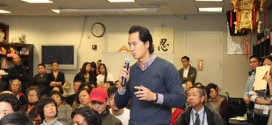
By Yi Chen
The Historic Preservation Office accepted a proposal to increase the boundary of the Downtown Historic District that was submitted on January 8, 2013 by the DC Preservation League, a nonprofit organization. The proposal will affect 22 properties in Chinatown.
Currently, Washington, DC’s Chinatown spans about 4 blocks. Its present boundaries are 5th Street NW on the east side, G Street on the south side, 8th street on the west side and Massachusetts Avenue on the north side.
The proposed boundary increase includes 600 & 800 blocks of H Street NW, the 800 block of 8th Street, and the 700 & 800 blocks of 6th Street NW. The Friendship Archway, 19 buildings, and two vacant lots are included. Construction dates of the existing buildings range from 1830 to 1986.
On April 10, Office of Planning and the Mayor’s Office on Asian Pacific Islander Affairs convened a community meeting at the Chinatown Community Cultural Center to “hear what people have to say,” according to Historic Preservation Officer David Maloney. “We realized that it was important for us to get out to the community,” he said. Some fifty to sixty Chinatown residents and business owners attended the meeting, but most of them did not welcome the proposal.
Audrey Wong, whose family owns the Ming’s Restaurant on 617 H Street NW, said she didn’t understand “what you’re all preserving” and “when things are broken and need repairing, it’s costing so much more and we can’t afford doing that kind of thing.” The three-story building housing the restaurant was constructed in 1859 and purchased by a Chinese resident in 1935. Despite some modifications, its original Italianate entry surround and hood remain intact. The proposal included the building because it contributes “to the significance of the expanded boundaries.”
Like Wong, many affected Chinatown property owners aren’t happy about the proposal along with the fact that they weren’t consulted in the preparation of the application. “You can’t just do it without consulting property owners when their properties are affected,” says Stephanie Change, Executive Director of the Chinatown Community Cultural Center. “That’s just not fair.” Her family owns the Tony Cheng’s Mongolian and Seafood Restaurant in Chinatown. Located at 619-621 H Street NW, the building was constructed in 1930 and redesigned in 1986 by Chinese American architect Alfred Liu, who also designed the Friendship Archway and Wah Luck House on 800 6th Street NW.
A modern six-story office building on 800 I Street constructed in 1999 is also included in the proposal. American Public Health Association currently owns the building. Its Office Services Director Ricardo Lovelace received a public notice from DC Office of Planning on January 24 informing him of DC Preservation League’s application. He thought it must be a mistake because the Association’s office building is neither historic nor does it have architectural importance connected to the history of Chinatown. “So I put it aside and didn’t pay much attention to it until I received the second notice on March 11.”
Lovelace expressed his confusion at the meeting. “I am trying to determine what is a building built in 1999 with no historical significance has to do with historical preservation,” he said. Peter Sefton, who is on the Board of Trustees of DC Preservation League, explained, “Occasionally there are individual buildings surrounded by historic buildings. Those are kept in as non-contributing buildings.” In this case, the office building is adjacent to the historic Greater New Hope Baptist Church, formally the Washington Hebrew Synagogue built in 1897.
What are the main implications for historic designations?
As listed in the Historic Preservation Guidelines, owners of buildings in the historic districts must have “certain exterior repairs, alternations and changes approved by the Historic Preservation Review Board prior to undertaking them. Similarly, the appearance of new additions and new buildings in the historic districts must also be approved by the Board prior to their construction.” Typically it’s much easier for non-contributing buildings to get permits for alternations.
However, Lovelace is greatly concerned that “once a building is designated as historical, three years from now if we decide to sell the building, the pool of people that will be interested in the building will be fairly limited because nobody wants to be hamstringed by historic designation.”
Paul Millstein, Vice President at Douglas Development Corporation, disagrees. “We deal with this frequently,” he said. “We are accustomed to have buildings that are not historically designated become historically designated after we own them.” The building that houses the Vapiano Restaurant, owned by Douglas, is included in the proposal to be included in the Downtown Historic District. “We’ve been through all parts of this process. We believe that historic preservation is a good thing. It respects the architectural fabric of the city.”
Douglas Development Corporation’s recent historic restoration projects include the Walgreens building on the corner of 7th and H Streets NW. Millstein believes properties are very valuable in the historic district. “We have proven that it’s actually more valuable in the historic district. We’ve got higher rents and we’ve leased properties faster because they had historic buildings attached to new construction.”
No doubt the economic values for real estate in Chinatown have skyrocketed in the last decade. Georgetown Law Professor Peter Byrne pointed out that historic preservation designations contribute greatly to such an increase, and property owners have already benefited from it. In the case of the American Public Health Association building, its value has increased around $5 million over the past 14 years.
Looking back in history, the Federal Triangle Project forced the relocation of Chinatown from Pennsylvania Avenue to H Street in 1931. When the old convention center was built in the early 1980s, parts of Chinatown were demolished. “I think there would have been a lot more of that without the Downtown Historic District,” Sefton said. “I think it’s been pretty successful in that respect. There are so much pressure to develop high rise office buildings downtown, to me it’s hard to see how buildings can survive if they weren’t protected in the District.”
Historic designation means official recognition and protection for Chinatown’s contribution to the cultural and aesthetic heritage of the nation’s capital. At the same time, it adds a new set of rules for property owners.
“We’ll be doing a lot more outreach trying to explain the process and what it all means,” Sefton said. “Obviously not everybody is going to agree with it, particular people who are planning to sell their building to a developer. They’re probably not going to agree with it and there is not much we can tell them. I think there could be very valid differences in opinion,” he observes. “I just hope to overcome some of the misunderstanding that are unnecessary.”
Lovelace told us he would try to fight the current proposal. He has contacted other proper owners who will get together to come up with a plan of their own.
The case is now in the public comment period, which takes place in the time between a public notice and the designation hearing. Affected property owners and any other interested persons concurring with or objecting to the designation can submit written comments to the Historic Preservation Review Board. Its nine members are appointed by the Mayor and approved by the District’s Council.
DC Preservation Regulations outline the process, requirements and criteria pertaining to the designation of historic districts. Before the upcoming hearing, the Historic Preservation Office will prepare a written report and recommendation for the Board and make it available to the public. The Board typically makes a decision at the hearing.
Advisory Neighborhood Commission 2C (Penn Quarter and Chinatown) declined to comment on the case but invited concerned owners, residents and citizens to attend its next public meeting at the Martin Luther King Jr. Memorial Library on May 13 at 6:30 p.m.
Asian Fortune will continue to follow this story as it develops.
Asian Fortune is an English language newspaper for Asian American professionals in the Washington, DC metropolitan area. Visit fb.com/asianfortune to stay up to date with our news and what’s going on in the Asian American community.
 Asian Fortune Your source for all things Asian American
Asian Fortune Your source for all things Asian American

